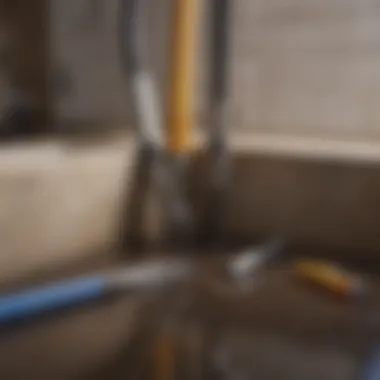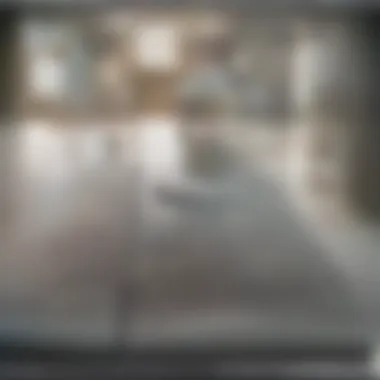Effective Methods to Clear a Clogged Drain Quickly


Intro
Clogged drains represent a significant inconvenience in any home. When water doesn't flow freely, daily tasks become burdensome. Often, this problem if left unattended, can escalate into more serious plumbing issues requiring professional intervention. Therefore, understanding effective methods to clear a clogged drain is vital for homeowners and do-it-yourself enthusiasts alike.
This article provides a thorough exploration of various techniques and tools that can be utilized to address these common blockages. Each method is evaluated based on its practicality, effectiveness, and suitability for different types of clogs. It will cover a spectrum from simple home remedies to advanced plumbing equipment, ensuring readers have a comprehensive guide at their disposal.
"Preventive maintenance can save time and money in the long run, ensuring a smoother flow in daily life."
As we delve into the strategies for clearing a clogged drain, we hope to equip you with the knowledge needed to tackle such issues as they arise. From chemical solutions to natural remedies, understanding how to manage clogged drains properly can greatly enhance the efficiency of your household plumbing.
Understanding Clogged Drains
Clogged drains can manifest in various ways, often leading to significant frustration for homeowners. It is crucial to comprehend the issue of clogged drains due to its far-reaching implications for household functionality and maintenance. Understanding how clogs form, their common causes, and potential consequences not only aids in immediatly addressing the problems but also allows for proactive prevention measures.
Overview of Drain Clogs
When water does not flow freely through a drain, it signals a clog. This blockage can occur in any drains throughout the home, including sinks, showers, and toilets. The inconvenience of clogged drains often disrupts daily activities, making it hard to carry out routine chores. If ignored, minor clogs may escalate into severe plumbing issues, possibly requiring extensive repairs and higher expenses. For these reasons, a thorough understanding of clogs is essential for every homeowner.
Common Causes of Clogs
Clogs can develop from various sources. Some typical contributors include:
- Hair: Strands can accumulate in drains, particularly in showers and sinks, creating obstructions.
- Grease: Disposal of oily substances down the sink can lead to buildup over time, creating a sticky trap for other debris.
- Food Waste: In kitchens, leftover food particles can build up in the plumbing system, especially in the absence of a garbage disposal.
- Soap Residue: Certain soaps combine with minerals in water to form soap scum, which can create clogs in bathroom drains.
- Foreign Objects: Items like toys or personal hygiene products can inadvertently be dropped into toilets, leading to blockages.
Recognizing these causes is vital in devising effective strategies to clear and prevent clogs.
Assessing the Type of Clog
Assessing the type of clog is crucial for effectively managing drainage issues in a home. Understanding the nature of a clog can lead to more precise solutions, thereby reducing the time and effort spent trying to rectify the situation. When drains become clogged, the underlying problem can often stem from various sources such as hair, grease, or foreign debris. Determining the specific type of clog helps in selecting the appropriate method or tool for clearing it. More importantly, this assessment can prevent further issues in the future,
Identifying Symptoms of a Clogged Drain
Recognizing the symptoms of a clogged drain can save significant hassle and prevent extensive damage. Some common indicators include:
- Slow draining water: When water takes longer to flow down the drain, it signals a potential build-up.
- Unpleasant odors: A foul smell originating from the drain often suggests stagnant water or decomposing material.
- Gurgling sounds: These sounds can imply trapped air escaping through the water, indicating a blockage.
- Backed-up water: Water pooling in your sink, tub, or floor drains clearly shows clogging.
Being aware of these signs is vital, as timely intervention can mitigate more severe plumbing problems.
Types of Clogs: Hair, Grease, and Debris
Drains can get clogged for a variety of reasons. Understanding these types can further aid in effective assessment and remediation. The primary types include:
- Hair Clogs: Hair accumulates over time in bathroom sinks, tubs, and shower drains. It often combines with soap and other residues to create a dense mass that obstructs water flow.
- Grease Clogs: In kitchens, grease from cooking can solidify in pipes, creating sticky blockages. These types of clogs can be particularly stubborn, as they often require heat or strong chemical agents to dissolve.
- Debris Clogs: Foreign objects or materials, like food particles, paper, or toys, can easily block drains. This type of clog varies significantly in composition and might necessitate specific mechanical tools for removal.
Identifying the right type of clog is key for choosing the correct clearing method.
In summary, regular drainage assessments and swift identification of symptoms significantly enhance the ability to address clogs. This foundational understanding empowers homeowners to maintain functional drainage systems.


Basic Tools for Clearing Drains
Clearing clogged drains requires the right tools. These tools not only make the task easier but also increase the chances of effectively resolving the issue. Understanding basic tools helps individuals navigate through different clog situations, enabling efficient problem-solving. The importance of having a well-equipped toolkit cannot be overstated. Homeowners and DIY enthusiasts will find that investing in these tools can save time and money over hiring a professional.
Plungers: Types and Uses
Plungers are among the most common tools for unclogging drains. They are simple yet effective, making them a staple in many households. There are two main types of plungers: the cup plunger and the flange plunger.
- Cup Plunger: This is the most recognizable type. It's ideal for clearing clogs in flat surfaces like sinks. Its rubber cup forms a seal around the drain, creating suction when pushed and pulled.
- Flange Plunger: This plunger has an extended rubber flap, making it more suitable for toilets. The flange design helps to create a stronger seal, enhancing its effectiveness in dealing with tougher clogs.
When using a plunger, ensure a tight seal. Start with firm yet careful pumping action. Keep an eye on the water level in the sink or toilet, and repeat until the clog dislodges. Plungers are cost-effective and require no special skills to use.
Drain Snakes and Augers
Drain snakes, also known as plumbing snakes or drain augers, are more advanced tools. They are particularly useful when plunging fails. Finding the right type of snake depends on the severity of the clog and its location.
Handheld drain snakes are ideal for minor clogs. They can be easily inserted into the drain, and the rotating action helps break up or pull out debris. On the other hand, a motorized auger can clear larger clogs, as it has a longer reach and more power.
Using a drain snake requires technique. Begin by inserting the end into the drain until you feel resistance. Turn the handle to either break up or hook the clog. This method is particularly effective for hair and grease buildups. However, caution is necessary as improper use may damage pipes.
Wet/Dry Vacuum as a Drain Cleaner
A wet/dry vacuum is another versatile tool for clearing clogged drains. This machine can handle both liquids and solids, making it an excellent option for various clog types. It is especially useful for greasy or sludge-like deposits, which may not respond well to other methods.
Using a wet/dry vacuum involves a few steps. First, remove any visible debris from the drain. Then, place the vacuum nozzle over the drain, creating a tight seal. Turn on the vacuum and allow it to suck the clog and debris out. If necessary, repeat the process with additional water to help dislodge stubborn clogs. A wet/dry vacuum can be a bit of an investment, but it is invaluable for maintaining a clean plumbing system.
In summary, having a variety of tools at hand is crucial for tackling clogged drains. Plungers, drain snakes, and wet/dry vacuums each serve unique functions, ensuring that different clog types can be effectively managed.
These tools not only aid in immediate relief but also contribute to long-term plumbing health when used correctly.
Home Remedies for Clogged Drains
Home remedies for clogged drains offer an effective and often economical solution to a common household issue. Many homeowners prefer to try these methods before resorting to expensive tools or professional services. Relying on natural ingredients readily available in most kitchens not only reduces costs but also minimizes the risk of harmful chemical exposure.
These remedies tend to be less aggressive compared to commercial cleaners, making them a responsible choice for those concerned about environmental impact. Moreover, regular use of these home remedies can prevent future clogs, maintaining the efficiency of your plumbing system.
Baking Soda and Vinegar Method
This method is perhaps the most popular home remedy for clogged drains. The combination of baking soda and vinegar creates a fizzy reaction that can help dislodge blockages. Start by pouring a half cup of baking soda down the drain, followed by a half cup of vinegar. You will notice bubbling as the two ingredients react.
Let the mixture sit for about 30 minutes, then flush with hot water. This can help dissolve minor clogs formed by grease or soap residue. Not only is this method simple, but it also avoids using harsh chemicals.
Salt and Boiling Water Technique
The salt and boiling water technique is another straightforward solution. Begin by boiling a kettle of water. Once boiling, add a half cup of salt to the water and stir until dissolved. Carefully pour the hot, salty water down the clogged drain. The high temperature helps to break down grease, while the salt works to scrub the insides of the pipes.
This method is quick and can yield results when clogs are caused by fat or oil residues. It’s an easy fix that homeowners can use regularly as a preventative measure.
Enzymatic Drain Cleaners


Enzymatic drain cleaners are a more recent addition to home remedies. These products use natural enzymes to break down organic material causing the clog. They can be especially effective for grease, hair, and food particles that build up over time.
To use, simply follow the instructions provided on the product. Unlike chemical drain cleaners, enzymatic solutions are generally safe for both your pipes and the environment. They work over time, so patience may be required, but they contribute to a cleaner and healthier home drainage system.
Consideration: While home remedies can be effective, they are not always a cure-all. It’s important to evaluate the severity of the clog and be ready to seek professional help if needed.
Commercial Drain Cleaning Solutions
When faced with a stubborn clog, homeowners often turn to commercial drain cleaning solutions. These products can be effective, and understanding their characteristics can help in deciding when to use them. Commercial solutions offer a range of options tailored to address different types of clogs, from hair and soap scum to grease build-up. The importance of this topic lies in the balance between efficacy and safety, along with environmental considerations that many consumers prioritize today.
One primary benefit of commercial drain cleaners is their ability to work quickly. Many products are designed for fast action, dissolving clogs without requiring extensive effort from the user. This can save valuable time and potentially prevent further damage to plumbing systems. However, it's vital to consider not only the immediacy of the solution but also its long-term impact on plumbing and the environment.
While utilizing commercial cleaners, readers must evaluate their safety profiles. Many chemical drain cleaners contain potent substances, such as sodium hydroxide or sulfuric acid, which can be hazardous to both people and pets. Furthermore, improper use can damage pipes, particularly older plumbing systems made of PVC or metal. Consequently, using these solutions responsibly is crucial.
Chemical Drain Cleaners: Efficacy and Safety
Chemical drain cleaners are among the most common commercial solutions available. They can be effective in breaking down tough clogs through chemical reactions that dissolve blockage materials. However, the use of these products requires an understanding of their efficacy and inherent safety risks.
- Efficacy: Chemical cleaners generally provide fast results. They often work by heating up and breaking down the clog. Users should, however, take note of the specific type of clog being addressed. For instance, while effective against grease, some cleaners may not work as well against solid debris.
- Safety: Extreme caution is advised when using these products. Chemical drain cleaners can cause burns, respiratory issues, and environmental harm. Wearing gloves and eye protection is essential, and using them in well-ventilated areas minimizes health risks. Additionally, these products should never be used in conjunction with other chemicals, as dangerous reactions could occur.
Biodegradable Drain Cleaning Products
Another option for those concerned about the environment is biodegradable drain cleaning products. These solutions utilize natural ingredients that break down organic material without the harsh chemicals found in traditional cleaners. They are generally safer for plumbing and less harmful to the environment, making them increasingly popular among conscientious consumers.
- Advantages: Biodegradable products tend to be safe for a variety of plumbing systems. Their natural composition means they are less likely to cause damage compared to strong chemical cleaners. Additionally, they have a lower risk of causing adverse effects on indoor air quality.
- Considerations: While biodegradable cleaners can be effective for smaller clogs, they may not provide the same immediate results as their chemical counterparts. Patience is necessary, as these products typically require more time to work. Moreover, they are often not as potent against tough blockages. For severe clogs, they might need to be combined with other methods for optimal success.
In summary, while commercial drain cleaning solutions provide an array of options for tackling clogged drains, it remains essential to consider their safety, efficacy, and environmental impact. Selecting the right type can make a significant difference in maintaining a healthy and efficient home plumbing system.
Preventive Measures to Avoid Clogs
Preventive measures are crucial in maintaining clear drains and ensuring a healthy plumbing system. By understanding potential risks, homeowners can take essential steps that not only mitigate clogs but also save time and expenses associated with plumbing issues. Prevention allows for smooth daily activities and contributes to the longevity of plumbing fixtures.
Regular Drain Maintenance Tips
Regular maintenance is key to preventing clogs. Here are several practices to incorporate into your routine:
- Routine Inspections: Conduct periodic checks of all drains to identify potential problems before they escalate.
- Flush Drains with Hot Water: Pour boiling water down the drains monthly to dissolve grease and debris buildup.
- Use Drain Covers: Install mesh covers to trap hair and other substances, preventing them from going down the drain.
- Clean P-Traps: Remove and clean P-traps under sinks regularly, as they can accumulate debris over time.
- Check Downspouts: Ensure that outdoor drains and downspouts are clear of leaves and other obstructions to prevent water from backing up.
These tips require minimal effort but yield significant benefits in minimizing clogs.
Proper Disposal Techniques
Incorrect disposal of waste can lead to severe drainage problems. To prevent clogs:
- Dispose of Cooking Grease Properly: Never pour grease down the sink. Instead, allow it to cool and dispose of it in the trash.
- Use Trash Bins for Food Scraps: Gather food scraps in a trash bin instead of washing them down the sink.
- Avoid Flushing Non-Biodegradable Items: Ensure only toilet paper and human waste are flushed. Items like cotton balls, wipes, and feminine products should go in the trash.
- Educate Household Members: Make sure everyone in the home understands proper disposal methods to ensure compliance.
Implementing these disposal techniques can greatly reduce the chance of drain blockages. By taking these preventive measures, homeowners can avoid the frustration of dealing with clogged drains while promoting a healthier living environment.


When to Call a Professional
Recognizing when to engage a plumbing professional is crucial for maintaining the integrity of your home plumbing system. Not all clogs are manageable with home remedies or basic tools. Some scenarios require expertise to not only clear the clog but to also prevent future plumbing issues. Understanding these circumstances can save you from more serious damage and costly repairs later.
Signs of a Serious Clog
Several indicators suggest a clog may be more severe than a simple blockage. Ignoring these signs can exacerbate the problem, potentially leading to extensive damage. Here are key symptoms to look out for:
- Persistent backups: If the water continues to back up after multiple attempts at clearing it, this may signal a deeper issue.
- Foul odors: Bad smells can indicate decaying organic matter trapped within the pipes, suggesting a blockage that requires professional assessment.
- Multiple drains affected: When more than one drain in your home is slow or clogged simultaneously, the issue may reside in the main sewer line. This calls for expert intervention.
- Gurgling noises: Unusual sounds from your drains can indicate trapped air, often linked to more significant clogs elsewhere in the system.
- Water pooling: If water frequently pools in your yard or inside your home, this is often a sign of sewer backup, requiring urgent professional help.
These signs help identify when you need to seek professional help. Ignoring them may lead to health risks related to water contamination and structural damage due to prolonged neglect.
Understanding Treatment Options from Professionals
When contacting a plumber, it is beneficial to know the treatment options available. Professionals utilize various methods depending on the severity of the clog:
- Camera inspections: Many plumbers employ video inspection tools to view the inside of your pipes. This helps determine the exact location and nature of the blockage without invasive methods.
- Hydro jetting: This method utilizes high-pressure water to thoroughly cleanse pipes, effectively removing stubborn debris buildup and restoring flow.
- Snaking: Professionals have specialized augers that can penetrate deeper clogs that are not reachable by standard tools.
- Chemical treatments: In some cases, licensed professionals may use stronger chemicals that are not available to consumers. However, safety and environmental impact are always considered.
- Repiping: For persistent issues, particularly in older homes with deteriorating pipes, replacement of damaged sections may be necessary.
Professional insight ensures that you are not only attempting to remove the clog but also addressing the underlying issues that could be contributing to repeated problems.
It’s often cheaper in the long run to invest in professional services than pay for extensive repairs caused by neglecting plumbing issues.
Impact of Clogged Drains on Home Environment
Understanding the impact of clogged drains is crucial for homeowners. Clogged drains can lead to a range of issues that affect both health and structural integrity. This article will delve into these concerns, outlining why addressing clogs promptly is imperative.
Health Risks Associated with Clogs
Clogs can become breeding grounds for bacteria and mold. When water backs up due to a clog, it creates stagnant pools that foster harmful microorganisms. This situation can lead to various health issues.
Some common health risks include:
- Respiratory problems: Mold spores can become airborne. Inhaling these spores can cause allergic reactions and respiratory issues.
- Skin irritation: Contact with drain water can result in skin infections.
- Gastrointestinal issues: If contaminated water comes into contact with food preparation areas, it may pose a risk of foodborne illnesses.
Given these potential health risks, it is essential to maintain clean and functional drainage systems. Regular inspections and timely interventions are key.
Structural Damage from Neglected Clogs
Neglecting clogged drains can lead to severe structural damage in the home. Over time, persistent clogs can cause water to leak into walls and floors. This leakage can result in:
- Water damage: Continuous water exposure to materials like wood can weaken structures. This might lead to sagging ceilings, warped floors, or even collapse in extreme cases.
- Foundation issues: Accumulated water can erode soil around the foundation. This erosion can compromise the structural stability of the home.
- Pest infestations: Moist environments tend to attract pests. Rodents and insects often seek shelter in damp areas caused by leaks from clogs.
It is clear that clogged drains can have far-reaching impacts on both health and structural integrity. Addressing drain issues promptly not only maintains a safe living environment but also preserves the longevity of the home.
"Ignoring clogged drains can set the stage for costly repairs and health risks. It is a matter of prioritizing home care."
Culmination
The importance of clearing clogged drains cannot be overstated. This article highlights various methods that can effectively address drain issues, ensuring that households maintain a smooth plumbing system. A well-functioning drain is essential for everyday activities, and delays in resolving clogs can lead to significant inconveniences.
Here, we summarize the methods presented throughout the article:
Summarizing Effective Clog Clearing Methods
- Basic Tools: Utilizing plungers, drain snakes, and wet/dry vacuums can provide immediate assistance in managing clogs. Understanding each tool's functionality can enhance efficiency.
- Home Remedies: Techniques involving everyday materials like baking soda, vinegar, and boiling water offer eco-friendly options. These methods are simple and often cost-effective while being safe for your plumbing.
- Commercial Solutions: Chemical drain cleaners are effective in specific scenarios. However, caution is needed regarding their safety and environmental impact. Alternative biodegradable products may provide a safer option without sacrificing effectiveness.
- Preventive Maintenance: Regular maintenance reduces the likelihood of clogs. Proper disposal techniques and routine inspections ensure that drains remain clear.
- Professional Assistance: When dealing with serious clogs or extensive damage, the expertise of a plumber can be invaluable. Understanding when to seek professional help is crucial to avoid further complications.















